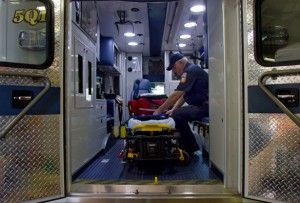Forum seeks change, support to improve EMS system

July 26, 2012
Increasing abuse and misuse of the Emergency Medical Service system may threaten more than just ambulance availability.
The Medical Transportation Advocacy Forum brought together southern Illinois health care providers, transit agencies and ambulance services July 19 at the Dunn-Richmond Center to discuss issues such as misuse and abuse of EMS services, patient education and coordination of non-emergency transportation.
Since patients brought to the hospital in an ambulance are required to be treated in the emergency room, misuse and abuse of the medical transportation system is an issue for hospitals.
Advertisement
Shirley Spangler, ER director at Franklin Hospital, said her facility often encounters patients using the ambulance services as taxicabs, expecting to walk in the doors and over to their appointments.
Once they come through the door, she said, the ER is required to treat them, which has also led some patients to pursue EMS rides to avoid their doctor’s waiting room.
Frequent EMS abusers, or “frequent flyers”, could include the elderly, homeless, impoverished, those without family support, a history of drug or alcohol abuse and recently-diagnosed patients, said Paul Davis, Adams County ambulance chief.
He said any increase in unpaid ER and ambulance bills caused by frequent flyers in turn adds cost to taxpayers.
Spangler said the abuse must stop because calling for a “cabulance” reduces the ability to respond to true emergencies, jeopardizing the health and safety of the rest of the community as well as the sustainability of the service.
“People expect an ambulance when they call 911,” Spangler said. “We will be in a world of hurt if we lose our EMS.”
Dennis Presley, project coordinator for the Rural Medical Transportation Network, said the keys to the project, conducted by the Center for Rural Health and Social Service Development at SIUC, will be to research the issues with the delivery of non-emergency and emergency medical transportation for rural residents, identify gaps in the system and the deficiencies that cause them, develop solutions and implement pilot programs.
Advertisement*
A survey of 34 southern Illinois counties about the non-emergency medical transportation network, conducted by the Center for Rural Health and Social Service Development, found 91 percent reported better transportation is somewhat needed and 51 percent reported that it was extremely needed.
Fifty-one percent of EMS agencies reported patients inappropriately request services up to 10 times every month that are not for emergency or medically necessary purposes, according to the survey.
While agencies most commonly experience misuse and abuse up to 10 times each month, the survey reported 26 percent experience it up to 20 times, 9 percent up to 30 times and 14 percent more than 30 times each month.
The impact, Presley said, is ultimately a poorer quality of life for Illinois patients.
He said the purpose of the project is ultimately to prevent people from suffering and dying because they can’t find non-emergency transportation or don’t understand how to obtain it, and EMS services are being diverted to those who are misusing or abusing the system.
Dottie Miles, director of the Jackson County Ambulance Service, said EMS service is a critical aspect in the nation’s ability to respond.
During the forum, Miles recollected several instances in which Health and Family Services did not reimburse the ambulance service, noting that often times the reimbursement barely covers the cost of medical supplies alone.
Ambulance services often cannot get reimbursed for providing non-emergency services, but are required to respond to calls regardless of circumstances, she said.
Miles said this makes ambulance services vulnerable and puts them at a loss because expectations for their services only increase while their ability to provide continues to decrease.
Presley said recommended actions may be to establish higher reimbursement for both emergency and non-emergency medical and health care transportation and to invest funding in the system that will result in greater financial savings to the health care system.
Such action may be to enact legislation that supports the diversion of patients to an appropriate mode of transportation, he said.
He said another possibility could be to pass legislation that establishes a co-pay for ambulance services, or some manner of a deterrent, that will significantly diminish the incidents of misuse and abuse, he said.
Presley said the support of mobility management initiatives is also necessary to coordinate non-emergency transportation by working closely with public transit and health care providers to see that no patient misses an appointment.
Presley said health care providers, transit agencies and ambulance services must work together and communicate because it is the only way issues will be solved.
“There is sometimes the failure to recognize EMS as an essential component of the health care system, as vital as any hospital, clinic or physician,” Presley said. “There are so many threats on the horizon to EMS, it may not be there if we don’t start paying attention to these issues.”
Advertisement







